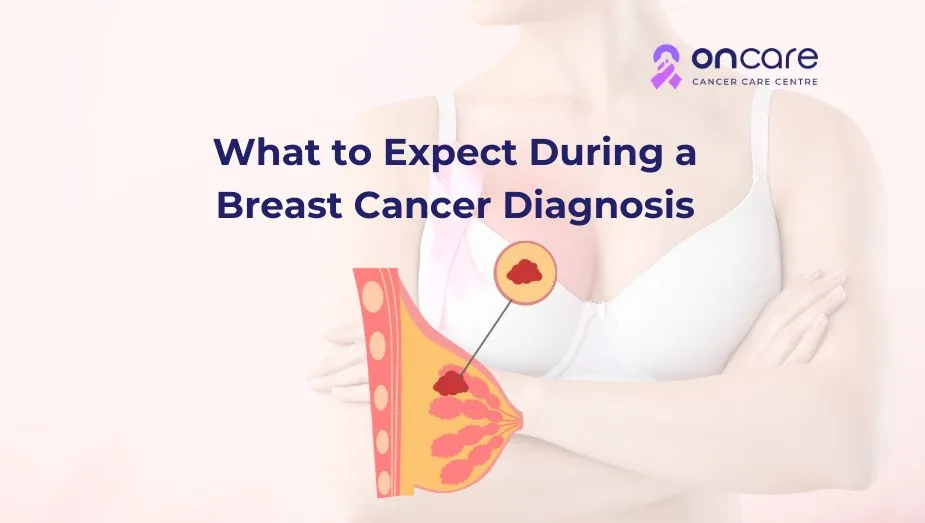Table of Contents
What to Expect During a Breast Cancer Diagnosis?

Receiving a positive breast cancer diagnosis can often be overwhelming. Understanding what to expect during a cancer diagnosis can help you to reduce the stress towards the uncertainties ahead of the treatment journey.
In this article, we’ll look more into the initial symptoms of this cancer and how each stage of the diagnostic process appears.
What’s to expect during a breast cancer diagnosis
A breast cancer diagnosis involves a series of steps, starting from recognizing the symptoms of this cancer. It is often followed by several medical examinations, such as lab tests and imaging tests.
However, additionally, biopsy tests are also performed to confirm the presence of cancerous cells in the breasts.
These may include:
- Early signs of breast cancer
- Clinical breast examination
- Review of your medical history
- Imaging tests
- Biopsy tests
- Pathology report results
- Cancer staging
- Consulting oncologists
- Emotional support
Early signs of breast cancer
The breast cancer diagnosis process usually starts when you start to notice early symptoms of this cancer.
Including:
- A new lump or mass thickening under the breasts or underarms
- A change in the size, color, and skin
- Consistent pain
- Swelling in the breasts
- Clear fluid discharge from the nipple
- A hard, thickened area under the skin
Once you recognize these symptoms on your breasts, consult an oncologist. Get your physical examination and discuss symptoms with the doctor to get more information.
Clinical breast examination
An oncologist will review your medical history, family history of cancer, and lifestyle factors. They will perform a clinical breast examination, in which the medical team manually checks on the suspected cancer patients. They check the lymph nodes in both breasts to find out any abnormalities.
Reviewing the medical history of patient
The medical team will also review the previous medical history of the patient; this includes identifying any medical conditions for which the patient has taken any regular medications.
They also identify any family history of cancer in the patient's life, including breast and ovarian cancers.
Imaging tests
If any abnormalities are identified in the suspected patients, then imaging tests are recommended to identify or collect more information.
- Mammogram: An X-ray of the breasts to spot any suspicious abnormalities or masses.
- Ultrasound: It is important to determine between any solid tumors or fluid-filled cysts
- MRI (Magnetic Resonance Imaging): It is often recommended in certain cases for more detailed imaging views.
Performing these tests helps to determine the size, shape, and location of any unusual growths.
Biopsy tests
If any imaging tests indicate the symptoms of potential cancer, then a biopsy is performed. During the biopsy procedure, a small sample of breast tissue is removed using one of the following methods.
It may include:
- Fine-needle aspiration biopsy
- Core needle biopsy
- Surgical biopsy
The collected tissue is often sent to a lab for pathological analysis to determine what type of cancer cells are present.
Pathology test results and Breast cancer staging
When the biopsy confirms the cancer in a patient, you may receive a pathology report that may include:
- Type of cancer (invasive ductal carcinoma)
- Grade and stage of tumor (how aggressive it looks under a microscope)
- Hormone receptor status (estrogen/ progesterone positive or negative)
- HER2 status
Your medical team will conduct further tests, including CT scans, PET scans, or bone scans, which may be used to stage the cancer from I to IV, indicating how far it has started.
Consulting Oncologists
You may be required to meet an oncologist's team and decide further treatment plans. These may include:
- Consultation with a medical oncologists
- Meeting a radiation oncologists
The medical team will help you to decide on your treatment plans and their effectiveness on your conditions. They will explain the diagnosis results and how to begin personalized treatment plans.
Emotional support
A breast cancer diagnosis can affect the mental and emotional well-being of a patient. Most women might feel fear, confusion or sadness.
The support resources may include:
- Consider getting counseling and mental health support
- Financial and insurance counselling
- Nutrition and dietitian counselling
Engaging with these support groups can provide strength and clarity as you move into the treatment.
Consult Today
A breast cancer diagnosis is a spine-chilling moment in a woman’s life. But knowing what to expect during each stage can empower you to make more informed decisions during the treatments. Early detection and timely attention can significantly impact the treatment outcomes.
Keeping an open communication with your oncologists and care teams helps you to prepare for the procedures. Know that you are not alone in this journey.
At Oncare, we offer high-quality cancer treatments, including cancer surgeries at affordable price ranges with an experienced cancer specialist consultation.
If you or any loved ones of yours are diagnosed with cancer, then visit Oncare Cancer Center and book an appointment with our cancer specialist today. Don’t wait for symptoms to start. Get an estimated cost of your cancer treatments today.
Frequently Asked Questions
There are two types of breast cancer include:
- Invasive (infiltrating) ductal carcinoma (IDC)
- Lobular breast cancer
- Ductal carcinoma in situ (DCIS)
There are some breast cancer subtypes, including:
- ER- Positive (ER+)
- PR- Positive (PR+)
- HR-Positive (HR+)
- HR- Negative (HR-)
- HER2- Positive (HER2+)
The common symptoms of breast cancer include:
- A change in the size, shape, or color of the breast
- A mass or lump, which can feel as small as a pea
- A thickening or lump near the breast or in the underarm that continues through the menstrual cycle.
- A change in the appearance or feel of the skin on your breast or nipple.
- Breast skin might appear dimpled, puckered, scaly, or inflamed.
- The breast or breast skin might appear red, purple, or darker than other parts of the breast.
- A marble-like hardened area under the skin
- A blood-stained or clear fluid discharge coming from the nipple.
Several studies suggest that breast cancer happens when the breast cells mutate and become cancerous cells that divide and multiply to develop tumors.
However, there are some studies that show that there are several risk factors that might increase the chances of developing breast cancer.
These include:
- Women above the age of 55 or older
- Women are highly prone to develop these types of cancer
- Family history of cancer mainly breast cancer
- Genetic mutations include BRCA1 and BRCA2 genes
- Smoking habits
- Excessive alcohol consumption
- Obesity or over weight
- Radiation exposure
- Hormone therapy

